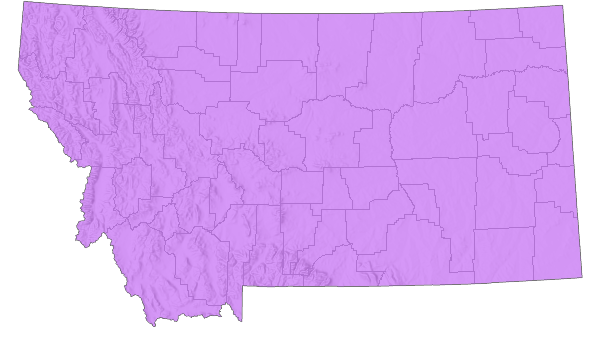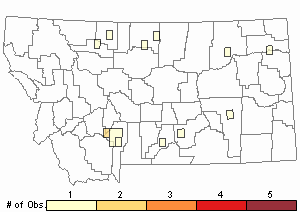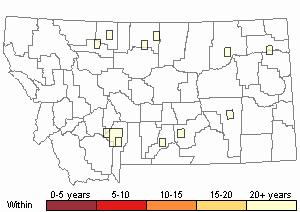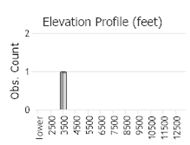View in other NatureServe Network Field Guides
NatureServe
Montana
Utah
Wyoming
Idaho
Wisconsin
British Columbia
South Carolina
Yukon
California
New York
Large-headed Grasshopper - Phoetaliotes nebrascensis
General Description
The following comes from Hebard (1928), Helfer (1971), Vickery and Kevan (1985), Pfadt (2002), Capinera and Sechrist (1982), Capinera et al. (2004), Brust et al. (2008), and Scott (2010). The head is exceptionally large compared to the thorax, being broad, deep, and noticeably slanted in lateral view. Wings (tegmina) usually short, extending only to the second or third abdominal segment. There are rarer individuals (about 5 percent in a population) with long wings extending a few millimeters beyond the abdominal tip. Hind tibia is blue, greenish, or purplish. The general body color is light gray or brownish dorsally and often yellowish ventrally.
Phenology
Overwinters in the egg stage. Nymphs appear in late May and June. Adults are found from early July through October, sometimes into November (Vickery and Kevan 1985, Pfadt 2002, Capinera and Sechrist 1982, Capinera et al. 2004, Brust et al.2008, and Scott 2010).
Diagnostic Characteristics
The following comes from Hebard (1928), Helfer (1971), Vickery and Kevan (1985), Pfadt (2002), Capinera and Sechrist (1982), Capinera et al. (2004), Brust et al. (2008), and Scott (2010). The male body length is 21 to 25 mm, and female 23 to 33 mm. The dorsal pronotum (thorax) constricted posteriorly. Dorsal stripe on the outer face of the hind femur is brown, extending slightly into the medial area and yellowish below.
Could be confused for a Slant-faced Grasshopper, family Gomphocerinae, which lacks the ventral tubercle between the front legs or for any of the short-winged Melanoplus species. Check male genitalia for comparisons.
Species Range
Montana Range
Range Descriptions

 Native
Native
Range Comments
Occurs from western Indiana, westward to eastern California, and from southern Manitoba, Saskatchewan, and Alberta, southward to northern Mexico. Widely distributed in the western United States. In Montana, reported for 37 counties, covering the eastern two-thirds of the state (Hebard 1928, Vickery and Kevan 1985, Pfadt 2002, Capinera and Sechrist 1982, Capinera et al. 2004, and Scott 2010).
Observations in Montana Natural Heritage Program Database
Number of Observations: 15
(Click on the following maps and charts to see full sized version)
Map Help and Descriptions
Relative Density

Recency



 (Observations spanning multiple months or years are excluded from time charts)
(Observations spanning multiple months or years are excluded from time charts)
Habitat
This species prefers lush, tallgrass prairies and mixed tall grasslands, often being the dominant species present in such habitats. In shorter types of grasslands, it may be locally abundant in tall grass patches in swales, ravines, coulees, along streams, and roadsides (Pfadt 2002, Capinera and Sechrist 1982, and Capinera et al. 2004).
Food Habits
The Large-headed Grasshopper feeds almost exclusively on a diversity of grass species, which is unusual for a spur-throated grasshopper. Feeds heavily on
little bluestem, (
Schizachyrium scoparium),
big bluestem, (
Andropogon gerardii), and
Kentucky bluegrass, (
Poa pratensis) in tallgrass prairies. In mixed grass areas, it favors
western wheatgrass, (
Elymus smithii). Also favors some forbs, such as dandelion, salsify and skeletonweed (
Stephanomeria) (Pfadt 2002, Capinera and Sechrist 1982, and Capinera et al. 2004).
Reproductive Characteristics
The following comes from Pfadt (2002), Capinera and Sechrist (1982), and Capinera et al. (2004). Nymphs pass through 5 instars and develop slowly. Development time from instar I to adult stage requires about 55 days. In laboratory studies, short-winged females produced 120 eggs during a reproductive period set at 25 days. Pods of short-winged forms usually contain 28 eggs, whereas pods of long-winged forms contain 20 to 24 eggs arranged in two columns. Data relative to egg laying sites are uncertain, but some have been observed to occur in the crowns of grass clumps.
Management
Short-winged forms generally remain in the same area in which they developed. However, if the site dries and lacks food, they have been observed to move to more lush areas up to 100 feet. The less common long-winged forms possess strong powers of flight and can disperse considerable distances, which probably accounts for the species' large geographical distribution. In tallgrass prairies, the Big-headed Grasshopper is of little pest importance. In mixed-grass prairies, especially during droughts, it can have significant impacts of rangeland forage. In fall, adults may invade fields of winter wheat, feed on the seedlings, and consume the entire plants to ground level (Pfadt 2002).
Stewardship Responsibility
References
- Literature Cited AboveLegend:
 View Online Publication
View Online Publication Brust, M.L, W.W. Hoback, and R.J. Wright. 2008. The Grasshoppers of Nebraska. Lincoln, NB: University of Nebraska Extension Service, APHIS.
Brust, M.L, W.W. Hoback, and R.J. Wright. 2008. The Grasshoppers of Nebraska. Lincoln, NB: University of Nebraska Extension Service, APHIS. Brust, M.L., W.W. Hoback, and R.J. Wright. 2008. A Synopsis of Nebraska Grasshopper Distributions. Journal of the Kansas Entomological Society 81(3):208-255.
Brust, M.L., W.W. Hoback, and R.J. Wright. 2008. A Synopsis of Nebraska Grasshopper Distributions. Journal of the Kansas Entomological Society 81(3):208-255. Capinera, J.L. and T.S. Sechrist. 1982. Grasshoppers of Colorado: Identification, Biology, and Management. Fort Collins, CO: Colorado State University Experiment Station, Bulletin 584S. 161 p.
Capinera, J.L. and T.S. Sechrist. 1982. Grasshoppers of Colorado: Identification, Biology, and Management. Fort Collins, CO: Colorado State University Experiment Station, Bulletin 584S. 161 p. Capinera, J.L., R.D. Scott, and T.J. Walker. 2004. Field Guide to Grasshoppers, Katydids, and Crickets of the United States. Ithaca, NY. Cornell University Press.
Capinera, J.L., R.D. Scott, and T.J. Walker. 2004. Field Guide to Grasshoppers, Katydids, and Crickets of the United States. Ithaca, NY. Cornell University Press. Hebard, M. 1928. The Orthoptera of Montana. Proceedings of the Academy of Natural Sciences of Philadelphia, Vol. 80:211-306.
Hebard, M. 1928. The Orthoptera of Montana. Proceedings of the Academy of Natural Sciences of Philadelphia, Vol. 80:211-306. Helfer, J.R. 1971. How to Know the Grasshoppers, Crickets, Cockroaches, and Their Allies. Revised edition (out of print), Mineola, NY: Dover Publications.
Helfer, J.R. 1971. How to Know the Grasshoppers, Crickets, Cockroaches, and Their Allies. Revised edition (out of print), Mineola, NY: Dover Publications. Pfadt, R.E. 2002. Field Guide to Common Western Grasshoppers, 3rd edition. Laramie, WY: Wyoming Agricultural Experiment Station, Bulletin 912, modified by S. Schell and S. Schell for electronic publication. Accessed 19 February 2020. http://www.uwyo.edu/entomology/grasshoppers/field-guide/index.html#fieldguidetoc
Pfadt, R.E. 2002. Field Guide to Common Western Grasshoppers, 3rd edition. Laramie, WY: Wyoming Agricultural Experiment Station, Bulletin 912, modified by S. Schell and S. Schell for electronic publication. Accessed 19 February 2020. http://www.uwyo.edu/entomology/grasshoppers/field-guide/index.html#fieldguidetoc Scott, R.D. 2010. Montana Grasshoppers, Katydids, and Crickets A Pictorial Field Guide to the Orthoptera. MagpieMTGraphics, Billings, MT.
Scott, R.D. 2010. Montana Grasshoppers, Katydids, and Crickets A Pictorial Field Guide to the Orthoptera. MagpieMTGraphics, Billings, MT. Vickery, V. R. and D. K. M. Kevan. 1985. The grasshopper, crickets, and related insects of Canada and adjacent regions. Biosystematics Research Institute, Ottawa, Ontario. Publication Number 1777. 918 pp.
Vickery, V. R. and D. K. M. Kevan. 1985. The grasshopper, crickets, and related insects of Canada and adjacent regions. Biosystematics Research Institute, Ottawa, Ontario. Publication Number 1777. 918 pp.
- Additional ReferencesLegend:
 View Online Publication
View Online Publication
Do you know of a citation we're missing? Anderson, N.L. 1951. Field studies on the biology of range grasshoppers of southeastern Montana. M.Sc. Thesis. Bozeman, Montana: Montana State University. 96 p.
Anderson, N.L. 1951. Field studies on the biology of range grasshoppers of southeastern Montana. M.Sc. Thesis. Bozeman, Montana: Montana State University. 96 p. Anderson, N.L. 1962. Grasshopper-vegetation relationships on Montana grasslands. Ph.D Dissertation. Bozeman, Montana: Montana State University. 73 p.
Anderson, N.L. 1962. Grasshopper-vegetation relationships on Montana grasslands. Ph.D Dissertation. Bozeman, Montana: Montana State University. 73 p. Bland, R.G. 2003. The Orthoptera of Michigan—Biology, Keys, and Descriptions of Grasshoppers, Katydids, and Crickets. East Lansing, MI: Michigan State University Extension, Bulletin E-2815. 221 p.
Bland, R.G. 2003. The Orthoptera of Michigan—Biology, Keys, and Descriptions of Grasshoppers, Katydids, and Crickets. East Lansing, MI: Michigan State University Extension, Bulletin E-2815. 221 p. Gillespie, R.L.1992. Dynamics of grasshoppers (Orthoptera: Acrididae) at a rangeland-crop interference. Ph.D. Bozeman, MT: Montana State University. 111 p.
Gillespie, R.L.1992. Dynamics of grasshoppers (Orthoptera: Acrididae) at a rangeland-crop interference. Ph.D. Bozeman, MT: Montana State University. 111 p. Hebard, M. 1932. Notes on Montana Orthoptera. Proceedings of the Academy of Natural Sciences of Philadelphia. V. 84. pp 251-257.
Hebard, M. 1932. Notes on Montana Orthoptera. Proceedings of the Academy of Natural Sciences of Philadelphia. V. 84. pp 251-257. Henry, J.E. 1969. Protozoan and viral pathogens of grasshoppers. Ph.D. Dissertation. Bozeman, MT: Montana State University. 153 p.
Henry, J.E. 1969. Protozoan and viral pathogens of grasshoppers. Ph.D. Dissertation. Bozeman, MT: Montana State University. 153 p. Kirk, K. and C.R. Bomar. 2005. Guide to the grasshoppers of Wisconsin. Madison, WI: Wisconsin Department of Natural Resources, Bureau of Integrated Science Services PUB-SS-1008. 154 p.
Kirk, K. and C.R. Bomar. 2005. Guide to the grasshoppers of Wisconsin. Madison, WI: Wisconsin Department of Natural Resources, Bureau of Integrated Science Services PUB-SS-1008. 154 p. Larson, D.P. 1996. Evaluation of sweep sampling as a method for determining grasshopper community composition on rangeland. M.Sc. Thesis. Bozeman, MT: Montana State University. 92 p.
Larson, D.P. 1996. Evaluation of sweep sampling as a method for determining grasshopper community composition on rangeland. M.Sc. Thesis. Bozeman, MT: Montana State University. 92 p. Mussgnug, G.L. 1972. The structure and performance of an adult population of Aulocara elliotti (Thomas) (Orthoptera, Acrididae) near Billings, Montana. M.Sc. Thesis. Bozeman, MT: Montana State University. 97 p.
Mussgnug, G.L. 1972. The structure and performance of an adult population of Aulocara elliotti (Thomas) (Orthoptera, Acrididae) near Billings, Montana. M.Sc. Thesis. Bozeman, MT: Montana State University. 97 p. Sater, S. 2022. The insects of Sevenmile Creek, a pictorial guide to their diversity and ecology. Undergraduate Thesis. Helena, MT: Carroll College. 242 p.
Sater, S. 2022. The insects of Sevenmile Creek, a pictorial guide to their diversity and ecology. Undergraduate Thesis. Helena, MT: Carroll College. 242 p. Skinner, K.F. 1995. Plant and grasshopper community composition: indicators & interactions across three spatial scales. M.Sc. Thesis. Bozeman, MT: Montana State University. 144 p.
Skinner, K.F. 1995. Plant and grasshopper community composition: indicators & interactions across three spatial scales. M.Sc. Thesis. Bozeman, MT: Montana State University. 144 p.
- Web Search Engines for Articles on "Large-headed Grasshopper"
- Additional Sources of Information Related to "Insects"





